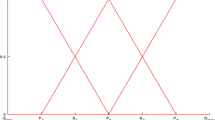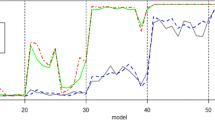Abstract
Single abnormal gene structure of disorders, specifically the alpha (α) and beta (β) thalassemia recessive disorders are focused. From the NCBI website, the preferred DNA sequencing is downloaded. The objective is to study the structure of Single Abnormal Gene using modified Box counting principle and FFD-Fuzzy Fractal Dimension analysis. Initially the fractal dimension method is used and analyzed single abnormal gene structure with the help of box counting method where the grids are segmented into triangles. Further the analysis is enhanced through grid and triangular method of improved box counting methods named as Ruby Triangular dimension which is the novelty of the research. Comparison of Grid Dimension with Triangular Dimension based fractal and fuzzy fractal dimension in the severity of disease from its secondary structure of the disorder related genes structures are performed. Further the complexity of the Single Abnormal Gene structure evaluated to generate a unique Attractor for the prediction of the α-thalassemia and β-thalassemia disorder in earlier diagnosis, refer as bifurcation theory. The results shows that the triangular Ruby Dimension based improved box counting method facilitate quick with more exactitude. In grid method the size of the image should be 2n pixels and shrink to at most 2048 pixels, whereas the triangular pixels may be reduced to 23 times than grid method. Hence, this novel Fuzzy Fractal Ruby Triangular Dimension method shows better results and can be applied for image of higher dimensions with the same procedure.

















Similar content being viewed by others
Explore related subjects
Discover the latest articles, news and stories from top researchers in related subjects.Data Availability
No data associated with this paper.
References
Ataga, K.I., Cappellini, M.D., Rachmilewitz, E.A.: β-Thalassaemia and sickle cell anaemia as paradigms of hypercoagulability. Br. J. Haematol. 139(1), 3–13 (2007)
Serindere, G., Belgin, C.: Evaluation of the effects of hemoglobinopathies on the mandible with fractal dimension analysis. Niger. J. Clin. Pract. 22(10), 1435–1440 (2019)
Baird, D.C., Batten, S.H., Sparks, S.K.: Alpha-and beta-thalassemia: rapid evidence review. Am. Fam. Physician 105(3), 272–280 (2022)
Deschavanne, P.J., Giron, A., Vilain, J., et al.: Genomic signature: characterization and classification of species assessed by chaos game representation of sequences. Mol. Biol. Evol. 16, 1391–1399 (1999)
Fiser, A., Tusnady, G.E., Simon, I.: Chaos game representation of protein structures. J. Mol. Graph. 12(302–304), 295 (1994)
Zhu, Y., Shen, N., Wang, X., Xiao, J., Lu, Y.: Alpha and beta-thalassemia mutations in Hubei area of China. BMC Med. Genet. 21, 1–5 (2020)
Milošević, N.: The morphology of the brain neurons: box-counting method in quantitative analysis of 2D image. In: The fractal geometry of the brain, pp. 109–126. Springer, New York (2016)
Yagmur, B., Tercanli-Alkis, H., Tayfun-Kupesiz, F., Karayilmaz, H., Kupesiz, O.A.: Alterations of panoramic radiomorphometric indices in children and adolescents with beta-thalassemia major: a fractal analysis study. Medicina Oral Patologia Oral y Cirugia Bucal 27(1), e10 (2022)
Rubini, S., Jeyabharathi, Latha, Seethalakshmi: Estimation of fractal dimension in the analysis of single abnormal gene structure. TAGA J. Gr. Technol. 14(70), 775–781 (2018)
Vijian, D., Ab Rahman, W.S.W., Ponnuraj, K.T., Zulkafli, Z., Noor, N.H.M.: Molecular detection of alpha thalassemia: a review of prevalent techniques. Medeniyet Med. J. 36(3), 257 (2021)
Wirasati, I., Rustam, Z., Aurelia, J.E., Hartini, S., Saragih, G.S.: Comparison some of kernel functions with support vector machines classifier for thalassemia dataset. IAES Int. J. Artif. Intell. 10(2), 430 (2021)
Susanto, E., Syarif, A., Muludi, K., Perdani, R., & Wantoro, A.: Implementation of fuzzy-based model for prediction of thalassemia diseases. Paper presented at the Journal of Physics: conference series (2021)
Aszhari, F., Rustam, Z., Subroto, F., & Semendawai, A.: Classification of thalassemia data using random forest algorithm. Paper presented at the Journal of Physics: Conference Series (2020)
Liangpu, Xu., Mao, A., Liu, H., Gui, B., Choy, K.W., Huang, H., Qian, Yu., Zhang, X., Chen, M., Lin, Na., Chen, L., Han, J., Wang, Y., Zhang, M., Li, X., He, D., Lin, Y., Zhang, J., Cram, D.S., Cao, H.: Long-molecule sequencing: a new approach for identification of clinically significant DNA variants in α-thalassemia and β-thalassemia carriers. J. Mol. Diagn. 22(8), 1087–1095 (2020)
Cesur, E., Bayrak, S., Kursun-Çakmak, E.Ş, Arslan, C., Köklü, A., Orhan, K.: Evaluating the effects of functional orthodontic treatment on mandibular osseous structure using fractal dimension analysis of dental panoramic radiographs. Angle Orthod. 90(6), 783–793 (2020)
Elkington, L., Adhikari, P., Pradhan, P.: Fractal dimension analysis to detect the progress of cancer using transmission optical microscopy. Biophysica 2(1), 59–69 (2022)
Panigrahy, C., Seal, A., Mahato, N.K.: Quantitative texture measurement of gray-scale images: fractal dimension using an improved differential box counting method. Measurement 147, 106859 (2019)
Cimen, M.E., Boyraz, O.F., Yildiz, M.Z., Boz, A.F.: A new dorsal hand vein authentication system based on fractal dimension box counting method. Optik 226, 165438 (2021)
Wu, M., Wang, W., Shi, D., Song, Z., Li, M., Luo, Y.: Improved box-counting methods to directly estimate the fractal dimension of a rough surface. Measurement 177, 109303 (2021)
Yan, J., Sun, Y., Cai, S., Hu, X.: An improved box-counting method to estimate fractal dimension of images. J. Appl. Anal. Comput. 6(4), 1114–1125 (2016)
Bisoi, A.K., Mishra, J.: On calculation of fractal dimension of images. Pattern Reconition Lett. 22(6–7), 631–637 (2001)
Castillo, O., Melin, P.: A hybrid fuzzy-fractal approach for time series analysis and plant monitoring. Int. J. Intell. Syst. 17(8), 751–765 (2002)
Castillo, O., Melin, P.: Hybrid intelligent systems for time series prediction using neural networks, fuzzy logic, and fractal theory. IEEE Trans. Neural Netw. 13(6), 1395–1408 (2002)
Lopes, L., Betrouni, N.: Fractal and multifractal analysis: a review. Med. Image Anal. 13(4), 634–649 (2009)
Melin, P., Castillo, O.: Intelligent control of aircraft dynamic systems with a new hybrid neuro–fuzzy–fractal approach. Inf. Sci. 142(1–4), 161–175 (2002)
Yang, L., Tang, Y.Y., Lu, Y., Luo, H.: A fractal dimension and wavelet transform based method for protein sequence similarity analysis. IEEE/ACM Trans. Comput. Biol. Bioinf. 12(2), 348–359 (2014)
Feng, J., Lin, W.-C., & Chen, C.-T.: Fractional box-counting approach to fractal dimension estimation. Paper presented at the proceedings of 13th international conference on Pattern recognition (1996)
Harrar, K., Hamami, L.: The box counting method for evaluate the fractal dimension in radiographic images, 6th WSEAS international conference, Cairo, Egypt (2007)
Mainieri, R.: On the equality of Hausdorff and box counting dimensions. Chaos Interdiscip. J. Nonlinear Sci. 3(2), 119–125 (1993)
Skubalska-Rafajłowic, E.: A new method of estimation of the box-counting dimension of multivariate objects using space-filling curves, nonlinear. Analysis 63, e1281–e1287 (2005)
Chen, W., Chen, X.-x., & Zhou, L.: Box-counting dimension analysis of edge images detected with classical edge detector. Paper presented at the 2010 international conference on measuring technology and mechatronics automation (2010)
Li, J., Qian, Du., Sun, C.: An improved box-counting method for image fractal dimension estimation. Pattern Recogn. 42, 2460–2469 (2009)
Al-Saidi, N.M., Mohammed, A.J., Ahmed, A.M.: Fuzzy fractal dimension based on escape time algorithm. Appl. Math. Sci. 8(3), 117–129 (2014)
Pedrycz, W., Bargiela, A.: Fuzzy fractal dimensions and fuzzy modeling. Inf. Sci. 153, 199–216 (2003)
Chow, S.-N., Hale, J.K.: Methods of bifurcation theory, vol. 251. Springer Science & Business Media, Berlin (2012)
Sattinger, D.H.: Group theoretic methods in bifurcation theory, vol. 762. Springer, New York (2006)
Golubitsky, M., Stewart, I.: Hopf bifurcation in the presence of symmetry. Arch. Ration. Mech. Anal. 87, 107–165 (1985)
Shang, X., Xu, X.: Update in the genetics of thalassemia: what clinicians need to know. Best Pract. Res. Clin. Obstet. Gynaecol. 39, 3–15 (2017)
Farashi, S., Harteveld, C.L.: Molecular basis of α-beta thalassemia. Blood Cells Mol. Dis. (2018). https://doi.org/10.1016/j.bcmd.2017.09.004
Sun, Y., Xue, B., Zhang, M., Yen, G.G., Lv, J.: Automatically designing CNN architectures using the genetic algorithm for image classification. IEEE Trans. Cybern. 50(9), 3840–3854 (2020)
Sarkheil, H., Rahbari, S., Rayegani, B.: Conversion based fuzzy fractal dimension integrating self-similarity and porosity, via DFS and FIS (Mamdani and Sugeno systems). Chaos Solitons Fract. 140, 110183 (2020)
Funding
No funding.
Author information
Authors and Affiliations
Corresponding author
Ethics declarations
Conflict of interest
The authors declare that they have no competing interest.
Ethical Approval
Not applicable.
Rights and permissions
Springer Nature or its licensor (e.g. a society or other partner) holds exclusive rights to this article under a publishing agreement with the author(s) or other rightsholder(s); author self-archiving of the accepted manuscript version of this article is solely governed by the terms of such publishing agreement and applicable law.
About this article
Cite this article
Sharon Rubini, P.K., Jeyabharathi, S. & Latha, B. Detection of Monogenic Disorders Using Fuzzy Fractal Analysis with Grids and Triangular Dimension. Int. J. Fuzzy Syst. 26, 2209–2223 (2024). https://doi.org/10.1007/s40815-024-01730-2
Received:
Revised:
Accepted:
Published:
Issue Date:
DOI: https://doi.org/10.1007/s40815-024-01730-2




